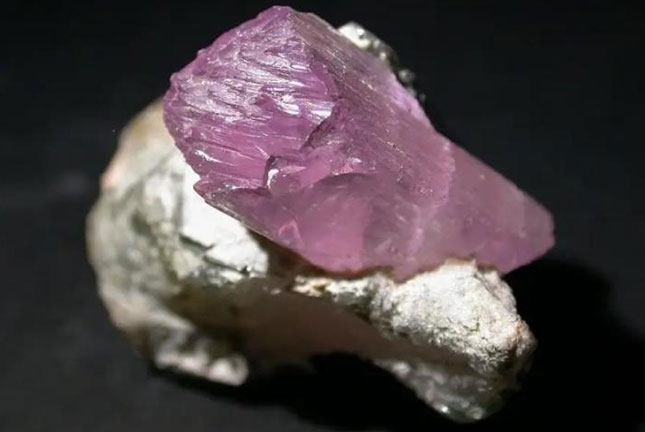
15311826613
Click to add WeChatIn the process of lithium resource development and utilization, the processing and purification of lithium-containing minerals such as spodumene and lepidolite have long been carried out. At present, among the more than 130 known lithium-containing minerals, the processing and purification of lithium-containing minerals such as spodumene and lepidolite has long been carried out. Only a few silicate and phosphate minerals have economic value. This article takes spodumene (chain silicate) and lepidolite (layered silicate) as examples to introduce their lithium extraction technology.

Lepidolite, also known as lepidolite, is a layered silicate mineral with a monoclinic crystal structure. Its basic framework is two silicon-oxygen tetrahedral mesh layers filled with octahedral coordinated cations, and lithium is sandwiched between the two tetrahedral mesh layers in the form of octahedral coordination. If lithium is to be extracted from lepidolite by leaching, it is necessary to release lithium from the encapsulation structure by roasting. Lepidolite can be roasted by a variety of reagents. Currently, there are several methods, including sulfate roasting, carbonate roasting, and chloride roasting, i.e., defluorination lime pressure treatment.
As it is difficult to directly leach lithium from lithium mica, it is then leached and precipitated to extract a concentration of 1% to 2%. Concentrated sulfuric acid is used to treat the mineral at a temperature of 150 to 170°C, replacing Li+ with H+ to form Li2SO4. The digested Li2SO4 suspension is then selectively dissolved in cold water. After removing the dissolved AL by CA(OH)2 precipitation, NA2CO3 is used as a precipitant to precipitate lithium in the form of Li2CO3 at 90°C.
Lithium can also be recovered by leaching lepidolite with water after roasting with CACO3. In this process, the mineral ground to the required particle size is roasted with CACO3 at 1000°C until the material is completely solidified]. The melt is treated with hot water to dissolve Li, NA, Rb, CS, CA and a small amount of Fe and Mg. Therefore, impurities are removed before Li2CO3 precipitation, and CA is separated by precipitating CACO3 by passing CO2 into the solution, and neutralized with HCL to convert it into chloride.
In addition to the sulfate and carbonate processes, lithium can also be extracted by leaching after chloride roasting. During calcination with sodium chloride and calcium chloride, lithium forms soluble chloride complexes such as NACL, CACL2 and mixtures thereof.
When lepidolite and sodium chloride are calcined at a mass ratio of 1:2 and 1:1, the product combinations are LiCL, KCL, NAALSi3O8 and SiO2. When CACL2 and lepidolite are calcined at a mass ratio of 1:2, the product combinations are LiCL, KCL, NAALSi2O6, SiO2, CAF2, CASiO3 and CAAL2Si2O8. When the mass ratio of CACL2 to lepidolite increases to 1:1, the LiALSi2O6 phase disappears.
Due to the incomplete diffusion of chlorine in lepidolite, the extraction efficiency in both cases is only 62%. Further roasting with a mixture of NACL and CACL2 increases the fluidity of chloride and reduces the viscosity of the liquid phase, thereby improving the extraction rate of lithium, because the melting point of the mixture of NACL and CACL2 is lower than that of NACL and CACL2. Therefore, the mixed chloride roasting is easier to diffuse to the surface of lepidolite than pure NACL or CACL2, and the extraction efficiency of Li is increased to 92.00% when maintained at 60℃ for 30min. After the leaching solution is purified under appropriate pH conditions, lithium is recovered in the form of Li2CO3.
Lepidolite is treated with steam (H2O) at high temperature to form LiAL(SiO3)2 (aluminum silicate), KALSi2O6 (leucite), and HF (hydrofluoric acid). During the heat treatment, H2O dissociates into H+ and OH-. H+ reacts with fluoride to form HF, and hydroxyl reacts with Si—O—Si bonds of lepidolite to form Si—OH groups. Si—OH groups can react with OH- to form new phases, such as H2O, leucite, or aluminum silicate. Under the optimal steam roasting conditions (860℃, 30miN), 42.3% of fluoride can be removed from lepidolite. The steam-treated lepidolite is further pressurized with NA2CO3 solution at 130℃ to obtain Li with a purity of about 99%. Based on the principle that the solubility of LiOH is lower than that of other alkali metal hydroxides, LiOH is recovered in the form of salt crystals. After redissolution, CO2 gas is introduced to generate LiHCO3, which is heated to 90~100℃ to precipitate Li2CO3.